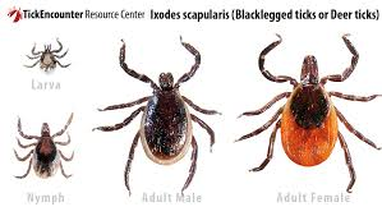Human Health

Increasing air temperatures and changing precipitation patterns have the potential to lead to the northward movement of zoonotic and vector-borne diseases. The current trends also have the potential to exacerbate zoonotic and vector-borne diseases that are already present.
Manitoulin Island had its first confirmed occurrence of the Black Legged Tick in 2017. However, it did not test positive for the bacteria causing Lyme Disease.
In 3 of the last 4 years Sudbury has had Black Legged Ticks test positive for Lyme Disease.
Certain species of Mosquitos on Manitoulin can carry the West Nile Virus which they pick up from birds. This virus can be transferred to humans, horses and other mammals.
Gore Bay
On average, Gore Bay had 2.1 days per year with temperatures exceeding 30 °C between 1981-2010. By the 2080’s it is projected that Gore Bay will experience 38.5 days per year with temperatures exceeding 30 °C.
Little Current
On average, Little Current had 1.5 days per year with temperatures exceeding 30 °C between 1981-2010. By the 2080’s it is projected that Little Current will experience 33.1 days per year with temperatures exceeding 30 °C.
South Baymouth
On average, South Baymouth had 0.5 days per year with temperatures exceeding 30 °C between 1981-2010. By the 2080’s it is projected that South Baymouth will experience 24.1 days per year with temperatures exceeding 30 °C.
An increase in air temperatures is likely to lead to an increase in heat-related illness such as exhaustion and heat stroke.
It is also expected that existing medical conditions related to respiratory, circulatory and nervous system health will be worsened by increasing air temperatures.
An increase in water temperatures could lead to an increase in the amount of algae growth and has the potential to increase the amount of harmful algae blooms that produce toxins.
Manitoulin Island had its first confirmed occurrence of the Black Legged Tick in 2017. However, it did not test positive for the bacteria causing Lyme Disease.
In 3 of the last 4 years Sudbury has had Black Legged Ticks test positive for Lyme Disease.
- It is suspected that the ticks are transported by the movement of migratory birds. Manitoulin is in the middle of a major flyway for a large number of migratory birds.
- Black Legged Tick’s go dormant when temperatures drop below 2 °C and will die off when temperatures drop below -12 °C and stay that way for several days.
Certain species of Mosquitos on Manitoulin can carry the West Nile Virus which they pick up from birds. This virus can be transferred to humans, horses and other mammals.
- Increased Summer and Fall air temperatures can increase the growth rate of mosquito populations, decrease the time interval between mosquito feeding, shorten the time from infection to infectiousness in mosquitoes, accelerate the rate of virus evolution and increase the efficiency of viral transmission to birds.
- Increased precipitation has the potential to increase the amount of standing water during the spring which could lead to higher mosquito abundance. However, increased spring precipitation could also flush mosquito larva out the drainage areas and ditches they typically breed in as well as diluting the amount of organic matter the larva needs to grow.
- Increased evaporation due to increased summer temperatures could lead to outbreaks of certain mosquito species as it concentrates organic matter in the standing water that remains. During drought conditions the interaction between birds and mosquitos increases as they both concentrate around the remaining standing water which accelerates the cycling and amplification of West Nile Virus within these populations.
Gore Bay
On average, Gore Bay had 2.1 days per year with temperatures exceeding 30 °C between 1981-2010. By the 2080’s it is projected that Gore Bay will experience 38.5 days per year with temperatures exceeding 30 °C.
Little Current
On average, Little Current had 1.5 days per year with temperatures exceeding 30 °C between 1981-2010. By the 2080’s it is projected that Little Current will experience 33.1 days per year with temperatures exceeding 30 °C.
South Baymouth
On average, South Baymouth had 0.5 days per year with temperatures exceeding 30 °C between 1981-2010. By the 2080’s it is projected that South Baymouth will experience 24.1 days per year with temperatures exceeding 30 °C.
An increase in air temperatures is likely to lead to an increase in heat-related illness such as exhaustion and heat stroke.
It is also expected that existing medical conditions related to respiratory, circulatory and nervous system health will be worsened by increasing air temperatures.
An increase in water temperatures could lead to an increase in the amount of algae growth and has the potential to increase the amount of harmful algae blooms that produce toxins.
- Blue green algae prefer warmer water temperatures and grow thicker and faster when there is little mixing due to increased periods of stratification.
- Small organisms can move faster in warm water which could allow for algae to float to the surface faster, where they can absorb heat radiation from the sun further warming water temperatures and exacerbating algal blooms.
- Algae require Carbon dioxide to survive and higher levels of it in the air and water can lead to rapid growth of algae.
- An increase in Spring and Fall precipitation with more drought conditions in the Summer can lead to massive nutrient run-off occurring all at once which increases algae growth.

